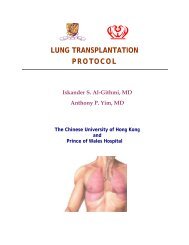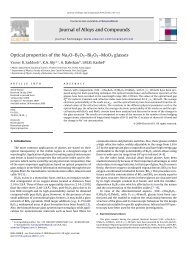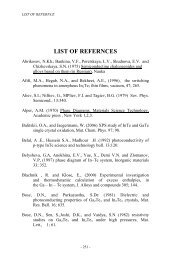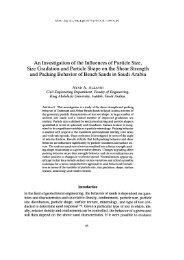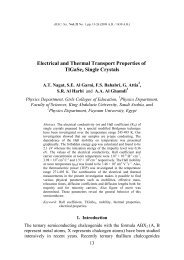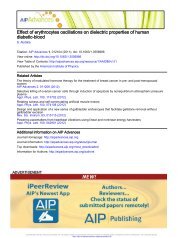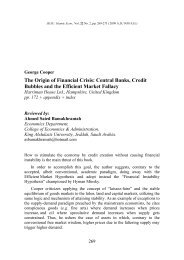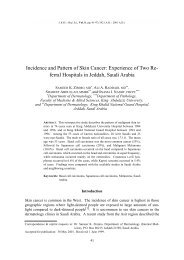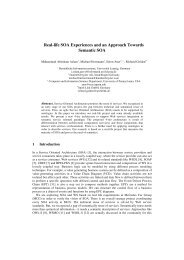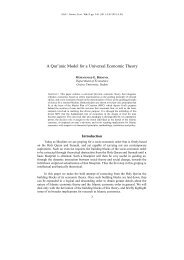Running OSCE for a Large Group of Students: Experience of the ...
Running OSCE for a Large Group of Students: Experience of the ...
Running OSCE for a Large Group of Students: Experience of the ...
You also want an ePaper? Increase the reach of your titles
YUMPU automatically turns print PDFs into web optimized ePapers that Google loves.
<strong>Running</strong> <strong>OSCE</strong> JKAU: <strong>for</strong> Med. a <strong>Large</strong> Sci., <strong>Group</strong> Vol. 12, <strong>of</strong> <strong>Students</strong>: pp: 43-52 <strong>Experience</strong> (2005 A.D. <strong>of</strong> / 1425-1426 <strong>the</strong> Surgical A.H.) Department ...<br />
43<br />
<strong>Running</strong> <strong>OSCE</strong> <strong>for</strong> a <strong>Large</strong> <strong>Group</strong> <strong>of</strong> <strong>Students</strong>:<br />
<strong>Experience</strong> <strong>of</strong> <strong>the</strong> Surgical Department<br />
King Abdulaziz University, Faculty <strong>of</strong> Medicine<br />
TALAL M. BAKHSH, FACHARTZ, RASHAD H. AL KASHGARI, FRCS(Glas),<br />
ABDULRAHMAN M. SIBIANY, FRCS(Ed), FAISAL M. AL MASHAT, FRCS(I)(Ed),<br />
ABDULRAHMAN A. MECCAWY, FRCS(Ed),<br />
FATMA K. AL THUBAITY, FRCS (I), and ADEL A. JOHARY, FRCS(I)<br />
Department <strong>of</strong> Surgery, Faculty <strong>of</strong> Medicine,<br />
King Abdulaziz University, Jeddah, Saudi Arabia<br />
ABSTRACT. The objective structured clinical examination is gaining<br />
popularity <strong>for</strong> its validity, reliability, and objectivity. It requires a lot<br />
<strong>of</strong> physical and financial resources and commitment. When it is used<br />
to test a large number <strong>of</strong> students it is time-consuming and needs a lot<br />
<strong>of</strong> preparatory work on <strong>the</strong> side <strong>of</strong> <strong>the</strong> organizers. This paper outlines<br />
<strong>the</strong> steps important to consider when running such an examination <strong>for</strong><br />
200 or more students.<br />
Keywords:<br />
<strong>OSCE</strong>, Assessment, Clinical, Undergraduate medical,<br />
Logistics.<br />
Introduction<br />
Since Harden et al., [1] introduced <strong>the</strong> objective structured clinical examination<br />
(<strong>OSCE</strong>) in 1975 as a means <strong>of</strong> assessing clinical competency by direct observation,<br />
it is being used increasingly <strong>for</strong> both under- and post- graduate students [2-6] .<br />
<strong>Students</strong> are expected to per<strong>for</strong>m a variety <strong>of</strong> clinical tasks within a specified<br />
time period and are judged against an objectively predefined set <strong>of</strong> criteria. It<br />
proved to be a reliable, valid, and reproducible test [4-8] .<br />
Correspondence & reprint requests to: Dr. Talal M. Bakhsh<br />
P.O. Box 80215, Jeddah 21589 Saudi Arabia<br />
Accepted <strong>for</strong> publication: 22 February 2005. Received: 07 December 2004.<br />
43
44<br />
T. M. Bakhsh et al.<br />
This paper is intended to show in some detail our experience with <strong>the</strong><br />
logistics <strong>of</strong> carrying out such an examination <strong>for</strong> a large group <strong>of</strong> students.<br />
Material and Methods<br />
There were 205 students (119 males + 86 females). The examination was<br />
per<strong>for</strong>med over 2 days. There were 10 active (history taking, physical examination)<br />
and 10 inactive stations (data interpretation, image interpretation, etc.).<br />
The time allowed <strong>for</strong> each station was 5 minutes.<br />
An organizing committee was established consisting <strong>of</strong> 6 members <strong>of</strong> <strong>the</strong><br />
department. They are responsible <strong>for</strong> <strong>the</strong> following areas: Examiners/staff,<br />
standardized patients (SPs), male/female students, housekeeping and catering,<br />
time and record keeping.<br />
FIG. 1. Location <strong>of</strong> examination.
<strong>Running</strong> <strong>OSCE</strong> <strong>for</strong> a <strong>Large</strong> <strong>Group</strong> <strong>of</strong> <strong>Students</strong>: <strong>Experience</strong> <strong>of</strong> <strong>the</strong> Surgical Department ...<br />
45<br />
Once this committee was established <strong>the</strong> location <strong>for</strong> <strong>the</strong> examination (Fig.<br />
1), and <strong>the</strong> room set up <strong>for</strong> active (Fig. 2) and inactive stations (Fig. 3) were determined.<br />
As can be seen from <strong>the</strong> floor plan (Fig. 1) <strong>the</strong>re were three identical<br />
lines <strong>of</strong> rooms which allowed three simultaneous examination lines. The rooms<br />
<strong>for</strong> active stations contained a patient bed, a com<strong>for</strong>table chair <strong>for</strong> <strong>the</strong> examiner<br />
with a table where <strong>the</strong> instruction sheet <strong>for</strong> <strong>the</strong> examiner and a stock <strong>of</strong> mark<br />
sheets are placed. On <strong>the</strong> o<strong>the</strong>r side a chair <strong>for</strong> <strong>the</strong> examinee is <strong>the</strong>re with a<br />
small table where <strong>the</strong> instruction sheet <strong>for</strong> <strong>the</strong> student is mounted. The patient’s<br />
instruction sheet is kept in <strong>the</strong> commode beside <strong>the</strong> bed. A clock is mounted on<br />
<strong>the</strong> wall. The room <strong>for</strong> an inactive station contains a chair <strong>for</strong> <strong>the</strong> student and<br />
table or desk with <strong>the</strong> instruction sheet and a stock <strong>of</strong> answer sheets and clock<br />
on <strong>the</strong> wall. On <strong>the</strong> table <strong>the</strong>re is, according to <strong>the</strong> subject <strong>of</strong> this station, an X-<br />
ray viewing box or a computer, or an instrument, etc.<br />
clock<br />
waste<br />
receptacle<br />
commode<br />
bed<br />
chair<br />
table<br />
chair<br />
table<br />
FIG. 2. Room set-up <strong>for</strong> ACTIVE station.<br />
table<br />
chair<br />
clock<br />
FIG. 3. Room set-up <strong>for</strong> INACTIVE station.
46<br />
T. M. Bakhsh et al.<br />
Letters were sent to <strong>the</strong> administration; detailing room set up <strong>for</strong> <strong>the</strong> stations,<br />
<strong>for</strong> waiting areas, secretarial areas, etc., to help furnish <strong>the</strong> rooms accordingly.<br />
The deadline <strong>for</strong> completion <strong>of</strong> <strong>the</strong> area setup was 3 days be<strong>for</strong>e <strong>the</strong> actual examination<br />
date.<br />
A department meeting was called. The subjects <strong>for</strong> <strong>the</strong> <strong>OSCE</strong> stations were<br />
determined and <strong>the</strong> authors <strong>for</strong> <strong>the</strong>se stations agreed upon. Deadlines <strong>for</strong> submission<br />
<strong>of</strong> <strong>the</strong> stations (including instruction sheets <strong>for</strong> examiners, patients and<br />
students and mark sheets) were fixed.<br />
As can be seen from Fig. 1, <strong>the</strong>re were 3 parallel lines with 10 <strong>OSCE</strong> stations<br />
each day. This way <strong>the</strong>re were 30 students in examination every hour. As <strong>the</strong>re<br />
were 205 students, <strong>the</strong> whole examination lasted 7 hours daily <strong>for</strong> 2 days.<br />
For each <strong>of</strong> <strong>the</strong> active stations, 5 examiners were made available (including<br />
<strong>the</strong> station author). Once <strong>the</strong> station writing was finalized <strong>the</strong> author met with<br />
his co-examiners to discuss <strong>the</strong> scenario and agree on a unified mark scheme.<br />
A plan <strong>for</strong> examiner’s rotation was established (Table 1).<br />
TABLE 1. Plan <strong>for</strong> examiner’s rotation.<br />
Assumption:<br />
Examination on 2 days<br />
10 stations per day<br />
3 lines <strong>of</strong> stations with 5 GS active stations each<br />
All department members participate<br />
Example <strong>of</strong> rotation <strong>of</strong> examiners in case <strong>of</strong> total <strong>of</strong> 5 examiners per station:<br />
Time Line I Line II Line III Resting<br />
0800 - 0850 1 2 3 4 + 5<br />
0900 - 0950 1 4 5 2 + 3<br />
1000 - 1050 2 4 5 1 + 3<br />
1100 - 1150 2 1 3 4 + 5<br />
1200 - 1250 4 1 3 2 + 5<br />
1300 - 1350 4 2 5 1 + 3<br />
1400 - 1450 1 3 5 2 + 4<br />
Working hours (h) <strong>for</strong>:<br />
Examiner 1 = 5 h<br />
Examiner 2 = 4 h<br />
Examiner 3 = 4 h<br />
Examiner 4 = 4 h<br />
Examiner 5 = 4 h<br />
For <strong>the</strong> active stations, we used only standardized patients (SPs). Nurses and<br />
porters from within <strong>the</strong> hospital were recruited. An adequate number <strong>of</strong> SPs <strong>for</strong><br />
each station was recruited to allow hourly rotation between work and rest. The<br />
station author was responsible <strong>for</strong> SP training.
<strong>Running</strong> <strong>OSCE</strong> <strong>for</strong> a <strong>Large</strong> <strong>Group</strong> <strong>of</strong> <strong>Students</strong>: <strong>Experience</strong> <strong>of</strong> <strong>the</strong> Surgical Department ...<br />
47<br />
<strong>Students</strong> were provided with an assignment card (Fig. 4) detailing <strong>the</strong> group<br />
assignment (corresponding to <strong>the</strong> time <strong>of</strong> examination) and <strong>the</strong> line and station<br />
assignment. Additionally each student was provided with 20 labels carrying<br />
name and computer number to be affixed on <strong>the</strong> mark sheets <strong>for</strong> every station.<br />
A detailed plan <strong>of</strong> <strong>the</strong> students’ grouping (Table 2) and movement (Table 3)<br />
were made available so that it was known to <strong>the</strong> students and investigators. A<br />
notice <strong>for</strong> all students not to bring any books or mobile phones to <strong>the</strong> examination<br />
area was put on <strong>the</strong> notice board.<br />
Front <strong>of</strong> card :<br />
Student is assigned to <strong>Group</strong><br />
To start at station<br />
in line<br />
Be available in <strong>the</strong> exam area be<strong>for</strong>e<br />
Back <strong>of</strong> card :<br />
Please affix student label here<br />
FIG. 4. Assignment card.<br />
The day be<strong>for</strong>e <strong>the</strong> examination, <strong>the</strong> organizing committee went through <strong>the</strong><br />
examination area to make sure all rooms were set up properly. Labels indicating<br />
station numbers, examination lines, waiting rooms and staff lounges<br />
were affixed.
48<br />
T. M. Bakhsh et al.<br />
On <strong>the</strong> day <strong>of</strong> examination, <strong>the</strong> organizing committee and department secretaries<br />
arrived an hour be<strong>for</strong>e <strong>the</strong> starting time to distribute instruction and<br />
mark sheets <strong>for</strong> <strong>the</strong> active stations, and <strong>the</strong> question and answer sheets <strong>for</strong> <strong>the</strong><br />
inactive stations.<br />
TABLE 2. <strong>Students</strong>’ groups.<br />
<strong>Group</strong> / Time Line 1 Line 2 Line 3<br />
<strong>Group</strong> 1 (0800 - 8050) 10 males 10 males 10 females<br />
<strong>Group</strong> 2 (0900 - 0950) 10 males 10 males 10 females<br />
<strong>Group</strong> 3 (1000 - 1050) 10 males 10 males 10 females<br />
<strong>Group</strong> 4 (1100 - 1150) 10 males 10 males 10 females<br />
<strong>Group</strong> 5 (1200 - 1250) 10 males 10 males 10 females<br />
<strong>Group</strong> 6 (1300 - 1350) 10 males 10 males 10 females<br />
<strong>Group</strong> 7 (1400 - 1450) 10 females 10 females 10 females<br />
TABLE 3. <strong>Students</strong>’ movements.<br />
At 0830 <strong>Group</strong> A (20 males + 10 females) directed to any room <strong>for</strong> I.D. check + label distribution.<br />
At 0900 They will go to <strong>the</strong> examiner.<br />
At 0930 <strong>Group</strong>s B, C, D will arrive (60 males + 30 males). They will be directed to rooms<br />
620 + 629 + 630 (males) and room 640 (females) <strong>for</strong> I.D. check + label distribution.<br />
At 0950 <strong>Group</strong> A will come out <strong>of</strong> exam and will be directed to rooms 639 (males) and 650<br />
(females) with continued supervision.<br />
At 0955 <strong>Group</strong> B will go to <strong>the</strong> exam area.<br />
At 1050 <strong>Group</strong> B will come out <strong>of</strong> exam and will be directed to rooms 620 (males) and 650<br />
(females) with continued supervision.<br />
At 1055 <strong>Group</strong> C will go to <strong>the</strong> exam area.<br />
At 1150 <strong>Group</strong> C will go out <strong>of</strong> exam. Males will be directed to rooms 620 (line 1) and 639<br />
(line 2) and females to room 650 with continued supervision.<br />
At 1155 <strong>Group</strong> D will to to exam.<br />
At 1230 <strong>Group</strong> E, F (males) and E, F, G (females) will arrive. Male students will be directed<br />
to rooms 620 (<strong>Group</strong> E) and 630 (<strong>Group</strong> F). Female students will be directed<br />
to rooms 640 (<strong>Group</strong>s E, F) and 649 (<strong>Group</strong> G).<br />
At 1250 <strong>Group</strong> D will come out <strong>of</strong> exam and can leave <strong>the</strong> exam area with <strong>Group</strong>s A, B and<br />
C.<br />
At 1250 <strong>Group</strong> E will to to exam and <strong>Group</strong>s F, G will be under continued supervision.<br />
At. 1350 <strong>Group</strong> E will come out <strong>of</strong> exam. They will leave <strong>the</strong> exam area immediately.<br />
At 1355 <strong>Group</strong> F will go to exam.<br />
At 1450 <strong>Group</strong> F will go out <strong>of</strong> exam and will leave.<br />
At 1455 <strong>Group</strong> G will to to <strong>the</strong> exam.
<strong>Running</strong> <strong>OSCE</strong> <strong>for</strong> a <strong>Large</strong> <strong>Group</strong> <strong>of</strong> <strong>Students</strong>: <strong>Experience</strong> <strong>of</strong> <strong>the</strong> Surgical Department ...<br />
49<br />
Five minutes be<strong>for</strong>e “start”, examiners and students were guided to <strong>the</strong>ir<br />
rooms. The timekeeper was ready with a big bell and a stopwatch. In each line<br />
<strong>the</strong>re was a time assistant with a big bell to make sure, <strong>the</strong> sound was heard in<br />
every room.<br />
Mark sheets were collected hourly after every group <strong>of</strong> students. The secretaries<br />
started entering <strong>the</strong> marks immediately. The resting examiners were requested<br />
to mark <strong>the</strong> answer sheets <strong>of</strong> <strong>the</strong> inactive stations immediately.<br />
<strong>Students</strong> and staff were given questionnaires to evaluate <strong>the</strong> examination.<br />
Results<br />
There were no problems encountered worth mentioning in <strong>the</strong> running <strong>of</strong> <strong>the</strong><br />
examination, especially <strong>the</strong>re was no delay in <strong>the</strong> timely progress <strong>of</strong> <strong>the</strong> examination.<br />
It was only noted that data entry was far more time consuming than<br />
estimated. The amount <strong>of</strong> food and beverages required <strong>for</strong> such a number <strong>of</strong><br />
people involved was also underestimated.<br />
Staff and students expressed high satisfaction with this type <strong>of</strong> examination<br />
(results <strong>of</strong> analysis <strong>of</strong> questionnaires will be reported separately).<br />
Discussion<br />
The principles <strong>of</strong> running <strong>OSCE</strong> examinations do not differ actually according<br />
to <strong>the</strong> number <strong>of</strong> students. Yet, <strong>the</strong> logistics <strong>of</strong> running such an examination<br />
<strong>for</strong> 200 or more students are extensive.<br />
We are in <strong>the</strong> <strong>for</strong>tunate situation <strong>of</strong> having a whole patient unit available with<br />
a lot <strong>of</strong> rooms to accommodate <strong>for</strong> 3 lines <strong>of</strong> examination, <strong>for</strong> waiting areas and<br />
lounges and secretarial <strong>of</strong>fices.<br />
An examination over 7 hours daily is tiring <strong>for</strong> examiners, SPs and organizers.<br />
A high degree <strong>of</strong> discipline and enthusiasm is required. A big number <strong>of</strong><br />
examiners and support staff (SPs, invigilators, timekeepers, secretaries, porters,<br />
and cleaners) are required. Because <strong>of</strong> <strong>the</strong> long hours, spacious waiting areas<br />
with com<strong>for</strong>table seating and sufficient supplies <strong>of</strong> food and beverages are additional<br />
factors contributing to <strong>the</strong> success <strong>of</strong> <strong>the</strong> examination.<br />
A very important factor leading to <strong>the</strong> success <strong>of</strong> <strong>the</strong> examination is meticulous<br />
and detailed written documentation <strong>of</strong> every aspect.<br />
The organizing committee has to meet frequently.<br />
Each committee member has an area <strong>of</strong> responsibility and must report on <strong>the</strong><br />
progress <strong>of</strong> preparation to <strong>the</strong> committee, especially in case <strong>of</strong> any difficulty.
50<br />
T. M. Bakhsh et al.<br />
Once timetables <strong>for</strong> examiners, SPs and students are established <strong>the</strong>y have to<br />
be sent to every involved person or group <strong>of</strong> persons.<br />
For reasons <strong>of</strong> confidentiality students must be in <strong>the</strong> examination area <strong>for</strong><br />
hours be<strong>for</strong>e and/or after <strong>the</strong> actual examination. They also need to be kept in<br />
spacious rooms under supervision to avoid contact between <strong>the</strong> different groups<br />
via mobile telephones. Because noise from such areas can be at times fairly<br />
high, <strong>the</strong>se rooms should be away from <strong>the</strong> actual examination rooms.<br />
Using junior house <strong>of</strong>ficers and nursing students as invigilators was a source<br />
<strong>of</strong> leak <strong>of</strong> in<strong>for</strong>mation about inactive stations. This was evident from some students’<br />
comments from <strong>the</strong> questionnaire. It was decided not to utilize <strong>the</strong>m in<br />
<strong>the</strong> next examinations.<br />
Most SPs felt uncom<strong>for</strong>table being on a bed in a history taking stations.<br />
They felt that such stations should be set up as an OPD room with a desk and<br />
two chairs <strong>for</strong> <strong>the</strong> SP and student on one side, and a chair and table <strong>for</strong> <strong>the</strong> examiner<br />
on <strong>the</strong> o<strong>the</strong>r side.<br />
Because <strong>of</strong> <strong>the</strong> parallel lines <strong>of</strong> stations timekeeping is very important. If an<br />
examiner is not present at <strong>the</strong> bell sound, a member <strong>of</strong> <strong>the</strong> organizing committee<br />
jumps in immediately. A 10-minute period is usually sufficient to organize <strong>the</strong><br />
change <strong>of</strong> students, SPs and examiners every hour.<br />
Deadlines must be established <strong>for</strong> decisions on<br />
♦ The choice <strong>of</strong> <strong>the</strong>mes <strong>for</strong> all stations<br />
♦ The station authors and co-examiners<br />
♦ The final written structure <strong>of</strong> each station<br />
♦ The readiness <strong>of</strong> <strong>the</strong> examination area<br />
Because it was <strong>the</strong> first time to implement this examination we faced some<br />
time delay in writing <strong>the</strong> active stations. Some stations were ready just a few<br />
days be<strong>for</strong>e <strong>the</strong> examination. A few reserve stations would make <strong>the</strong> organizing<br />
committee more at ease. It was decided to distribute <strong>the</strong> <strong>the</strong>mes <strong>of</strong> <strong>the</strong> active<br />
stations (according to <strong>the</strong> curriculum) among <strong>the</strong> staff members to write <strong>the</strong>m<br />
during <strong>the</strong> coming academic year. This way, stations are ready in a bank<br />
months ahead <strong>of</strong> <strong>the</strong> examination schedule. The department will <strong>the</strong>n only decide<br />
on <strong>the</strong> choice <strong>of</strong> <strong>the</strong> actual <strong>the</strong>mes.<br />
Ano<strong>the</strong>r area <strong>for</strong> future improvement is <strong>the</strong> inactive stations. Instead <strong>of</strong> mixing<br />
active with inactive stations it is suggested to hold up this examination part<br />
in a big auditorium where a computer presentation <strong>of</strong> <strong>the</strong> inactive station can be<br />
projected on a big screen and all students would answer <strong>the</strong> questions in a booklet.
<strong>Running</strong> <strong>OSCE</strong> <strong>for</strong> a <strong>Large</strong> <strong>Group</strong> <strong>of</strong> <strong>Students</strong>: <strong>Experience</strong> <strong>of</strong> <strong>the</strong> Surgical Department ...<br />
51<br />
References<br />
[1] Harden RM, Stevenson M, Downie WW, Wilson GM. Assessment <strong>of</strong> clinical competence<br />
using objective structured examination. Br Med J 1975; 1(5955): 447-451.<br />
[2] Kowlowitz V, Hoole AJ, Sloane PD. Implementing <strong>the</strong> objective structured clinical examination<br />
in a traditional medical school. Acad Med 1991; 66(6): 345-347.<br />
[3] Wilkinson TJ, Newble DI, Wilson PD, Carter JM, Helms RM. Development <strong>of</strong> a threecentre<br />
simultaneous objective structured clinical examination. Med Educ 2000; 34(10):<br />
798-807.<br />
[4] Sloan DA, Donnelly MB, Schwartz RW, Felts JL, Blue AV, Strodel WE. The use <strong>of</strong> objective<br />
structured clinical examination (<strong>OSCE</strong>) <strong>for</strong> evaluation and instruction in graduate<br />
medical education. J Surg Res 1996; 63(1): 225-230.<br />
[5] Duerson MC, Romrell LJ, Stevens CB. Impacting faculty teaching and student per<strong>for</strong>mance:<br />
nine years' experience with <strong>the</strong> Objective Structured Clinical Examination. Teach<br />
Learn Med 2000; 12(4): 176-182.<br />
[6] Davis MH. <strong>OSCE</strong>: <strong>the</strong> Dundee experience. Med Teach 2003; 25(3): 255-261.<br />
[7] Carraccio C, Englander R. The objective structured clinical examination: a step in <strong>the</strong> direction<br />
<strong>of</strong> competency-based evaluation. Arch Pediatr Adolesc Med 2000; 154(7): 736-741.<br />
[8] Elnicki DM, Shockcor WT, Morris DK, Halbritter KA. Creating an objective structured<br />
clinical examination <strong>for</strong> <strong>the</strong> internal medicine clerkship: pitfalls and benefits. Am J Med Sci<br />
1993; 306(2): 94-97.
52<br />
T. M. Bakhsh et al.<br />
s dO œbF ·«b_« sÒMI wu{u*« Ídd« —Uô« ¡«d≈<br />
eeF« b pK*« WFU VD« WOKJ W«d'« r Wd& ,WKD«<br />
, wUO# bL sLd«bË , ÍdIAI« s œU—Ë , g bL ‰ö<br />
, wO« fHOM WLUË , ÍËUJ bL√ sLd«bË , ◊UA*« bL qBO Ë<br />
Ídu wK ‰œU Ë<br />
, eeF« b pK*« WFU , VD«WOK , W«d'« r<br />
WœuF« WOdF« WJKL*« − …b‡‡‡<br />
·«b_« 4I?? wu?{u*« Íd?d?« —U?????ô« vE ÆhK???*«<br />
ÆWOU? WœUL«Ë WO?u{uË WO?«bB t Ê√ 5 YO? , …b«e WO?FA<br />
ÊUJ*« W?O?U s «e?O?N???« s d?O?J« h?H« s ŸuM« «c? VKD<br />
hH« «c ¡«d≈ bMË Æ◊U?Cô«Ë «eô« v≈ WU{≈ , ÍœU*« rb«Ë<br />
«Îb?N?Ë U?ÎË 5L?EM*« s VKD t e?O?N??« ÊS W?KD?« s dO?? œb?F<br />
ÁUô« V w« WUN« «uD)« vK ¡u?C« Y« «c jK ÆsdO<br />
s œb?F h??H« s ŸuM« «c ¡«d?≈ b?M —U???ô« w Uc??√Ë U?N?O≈<br />
ÆWUË VU ≤∞∞ s be WKD«



